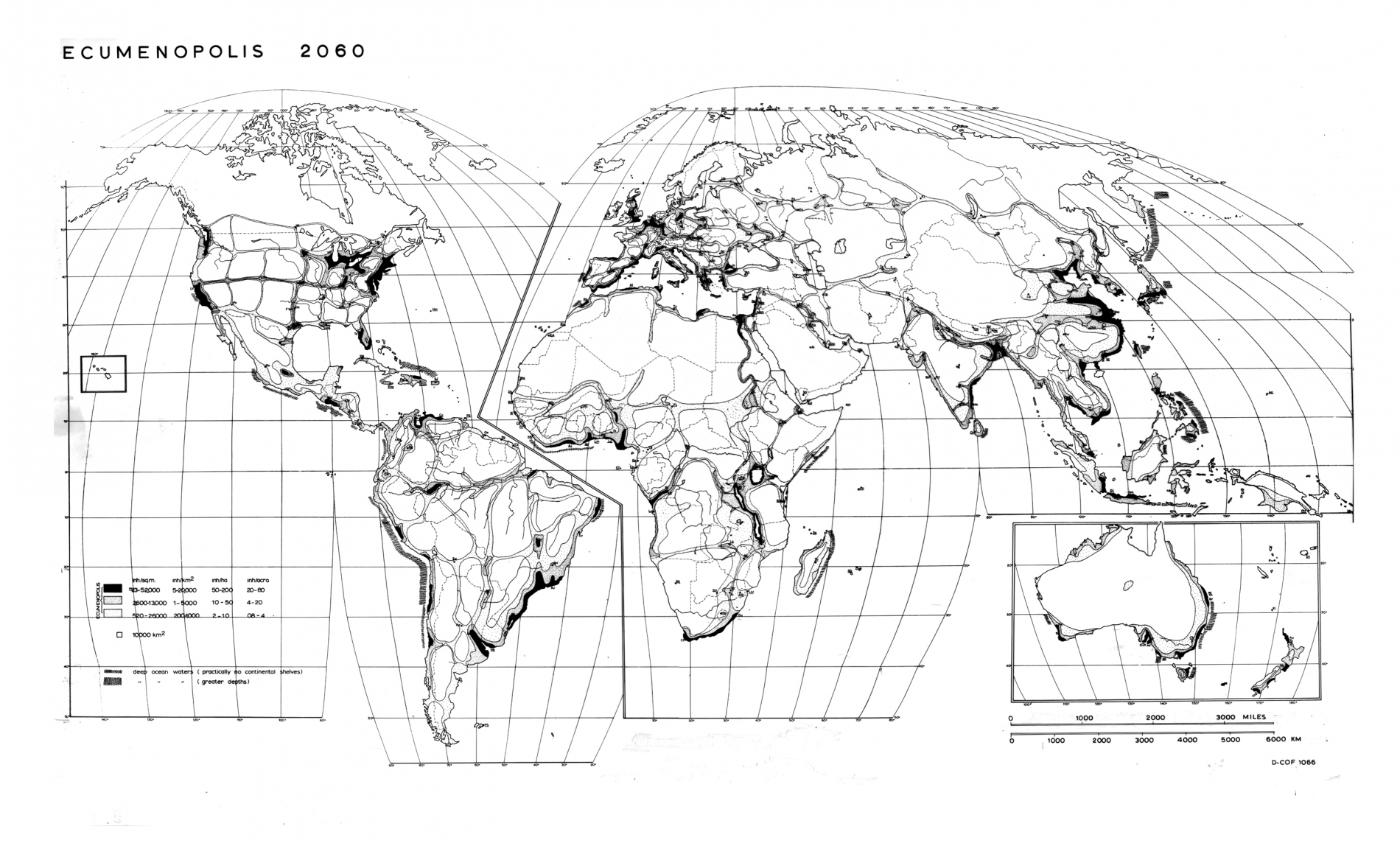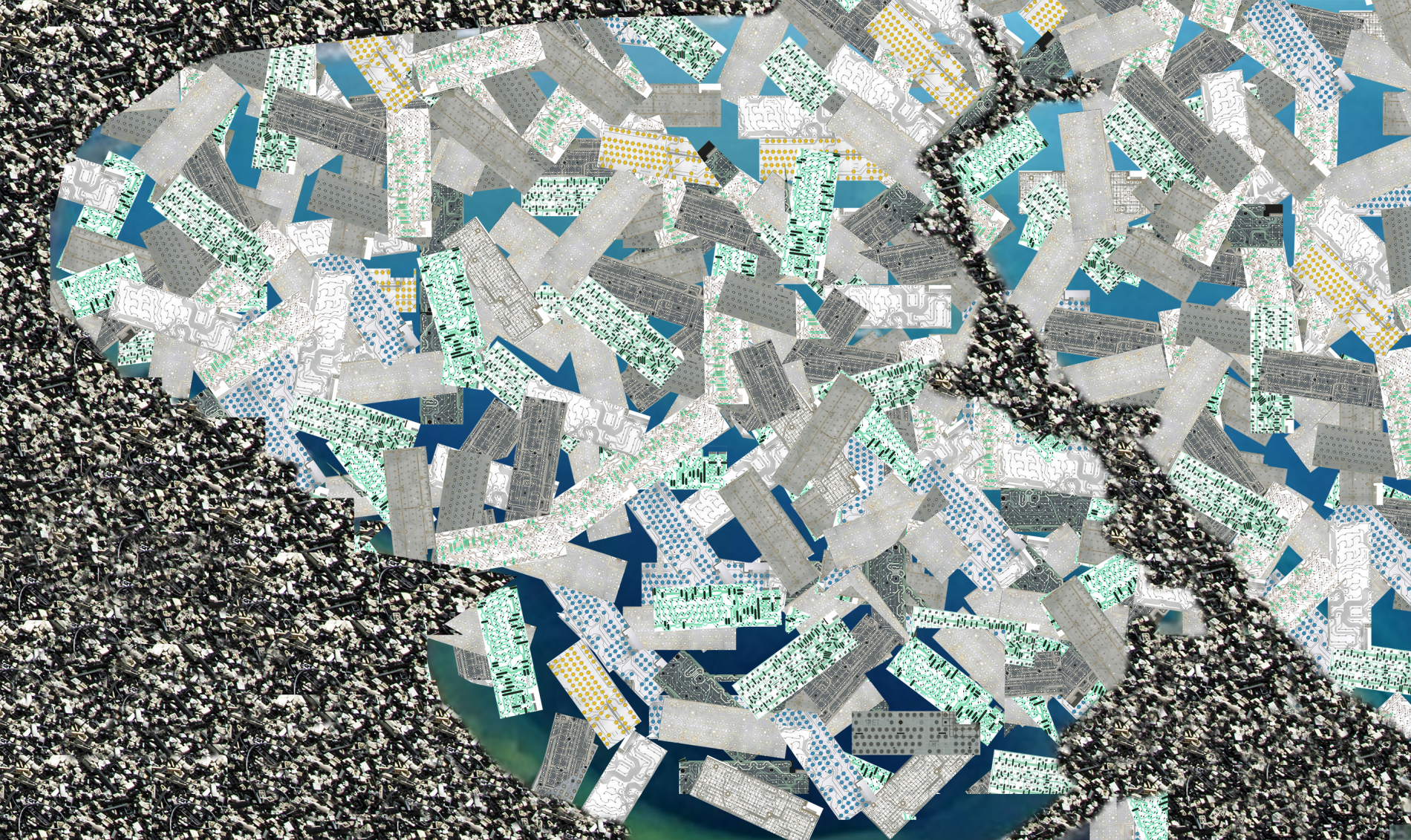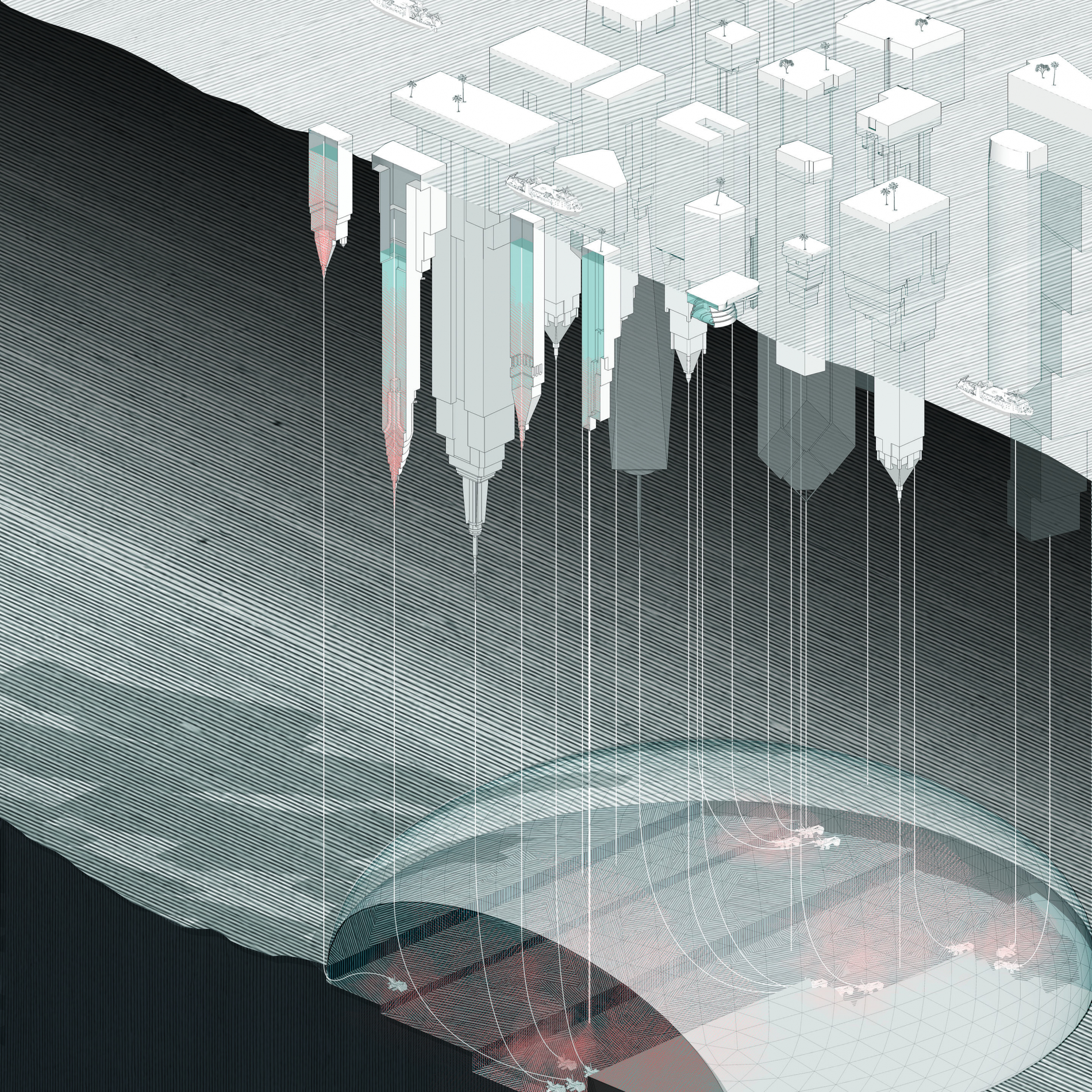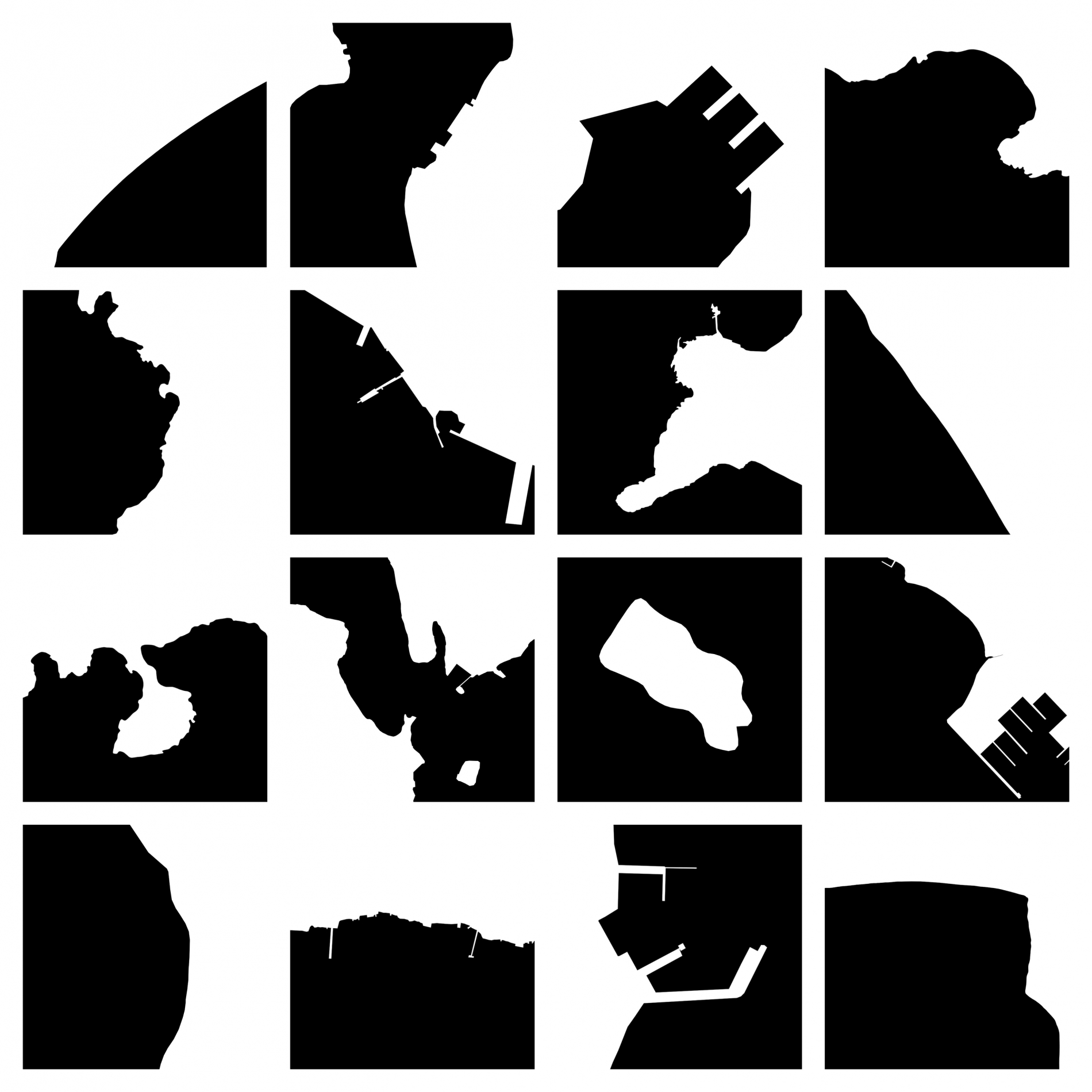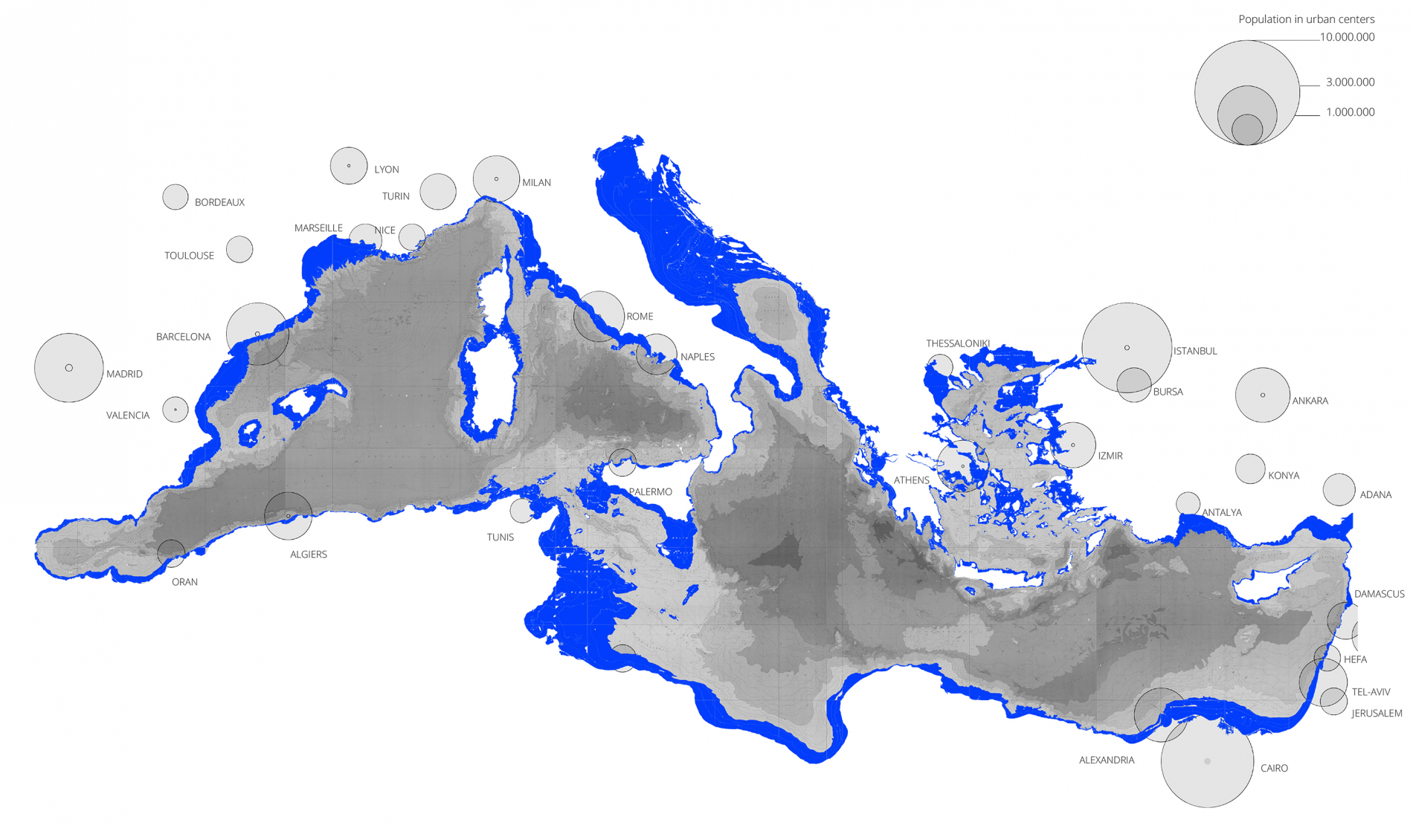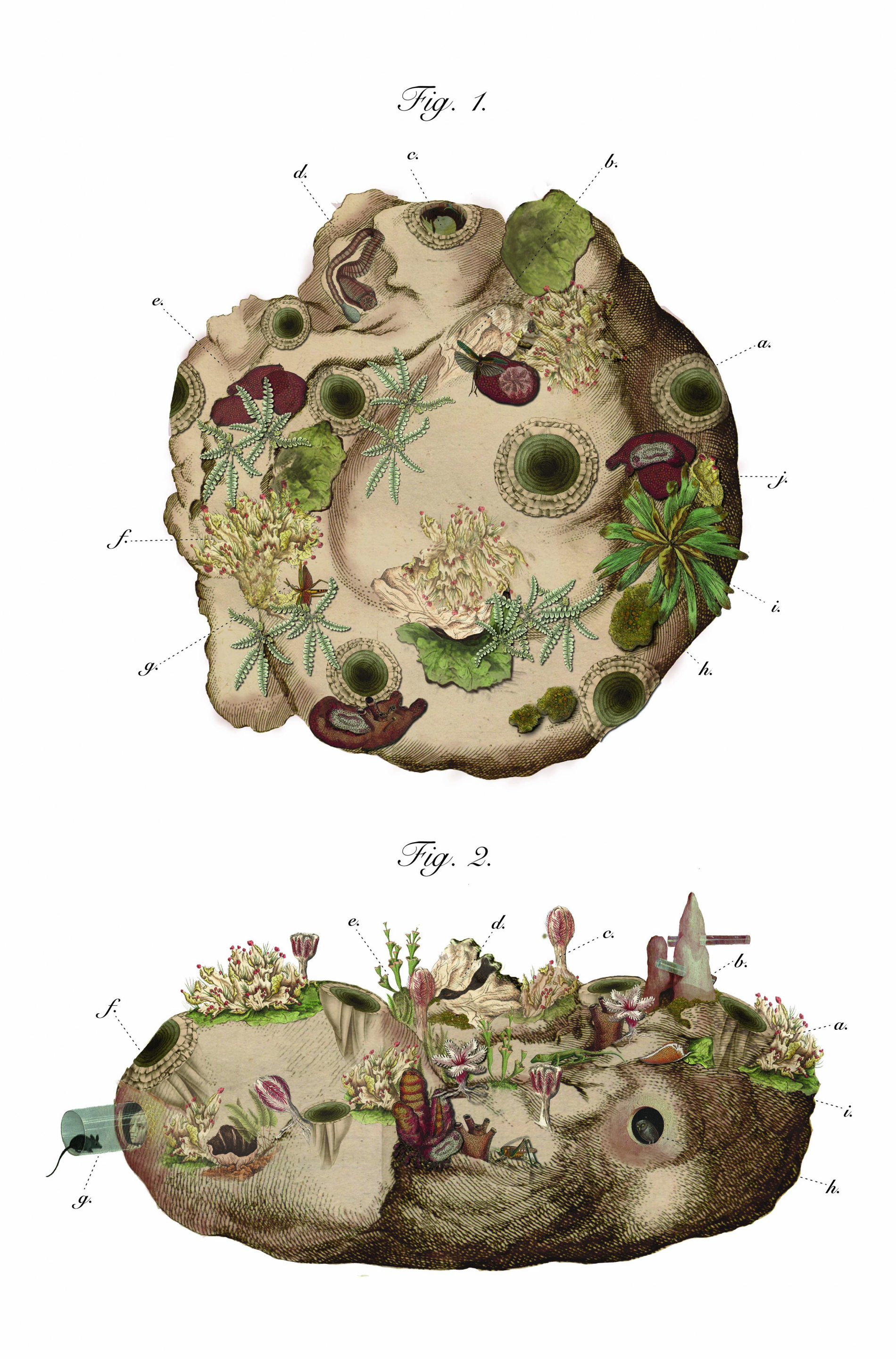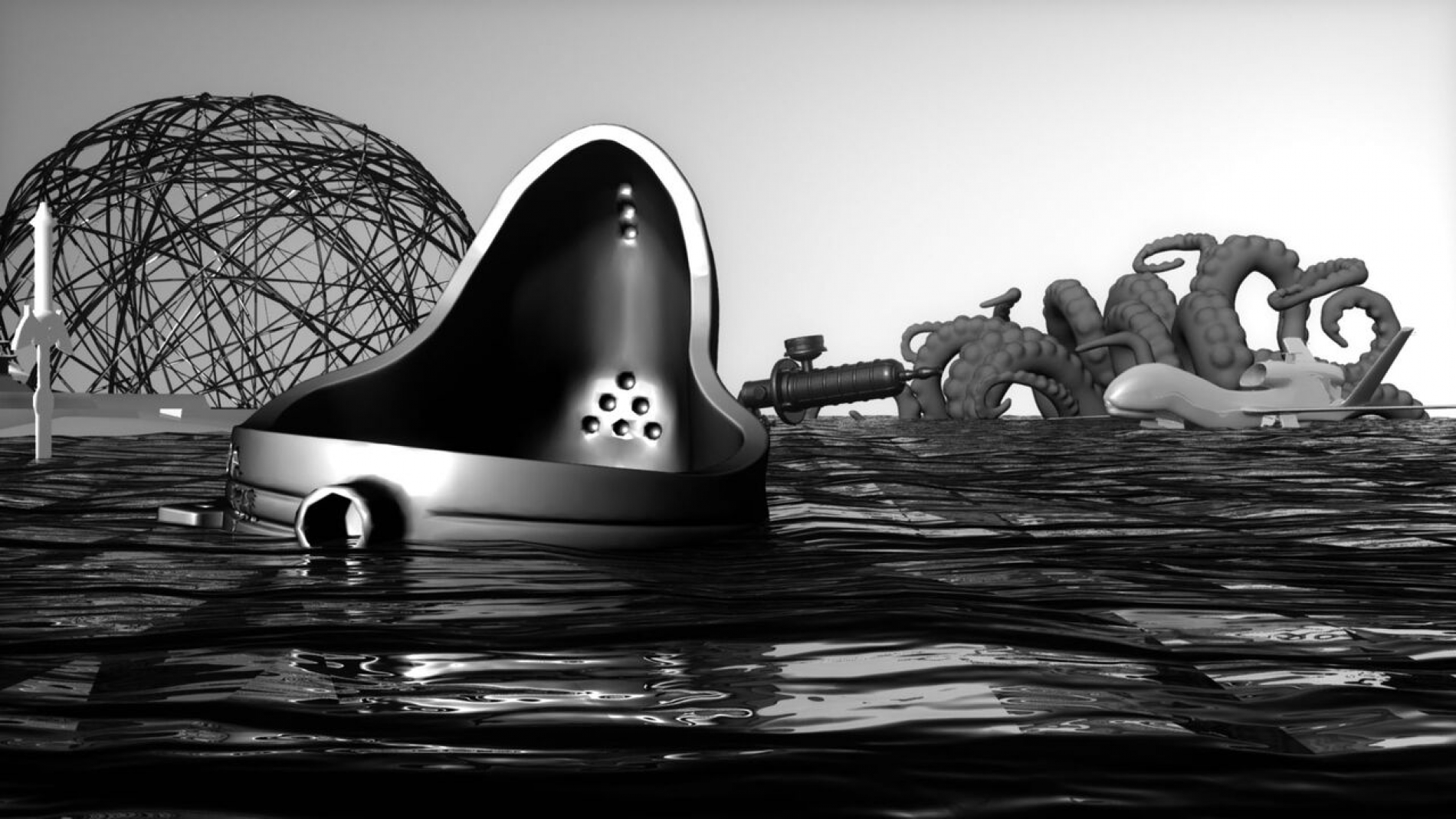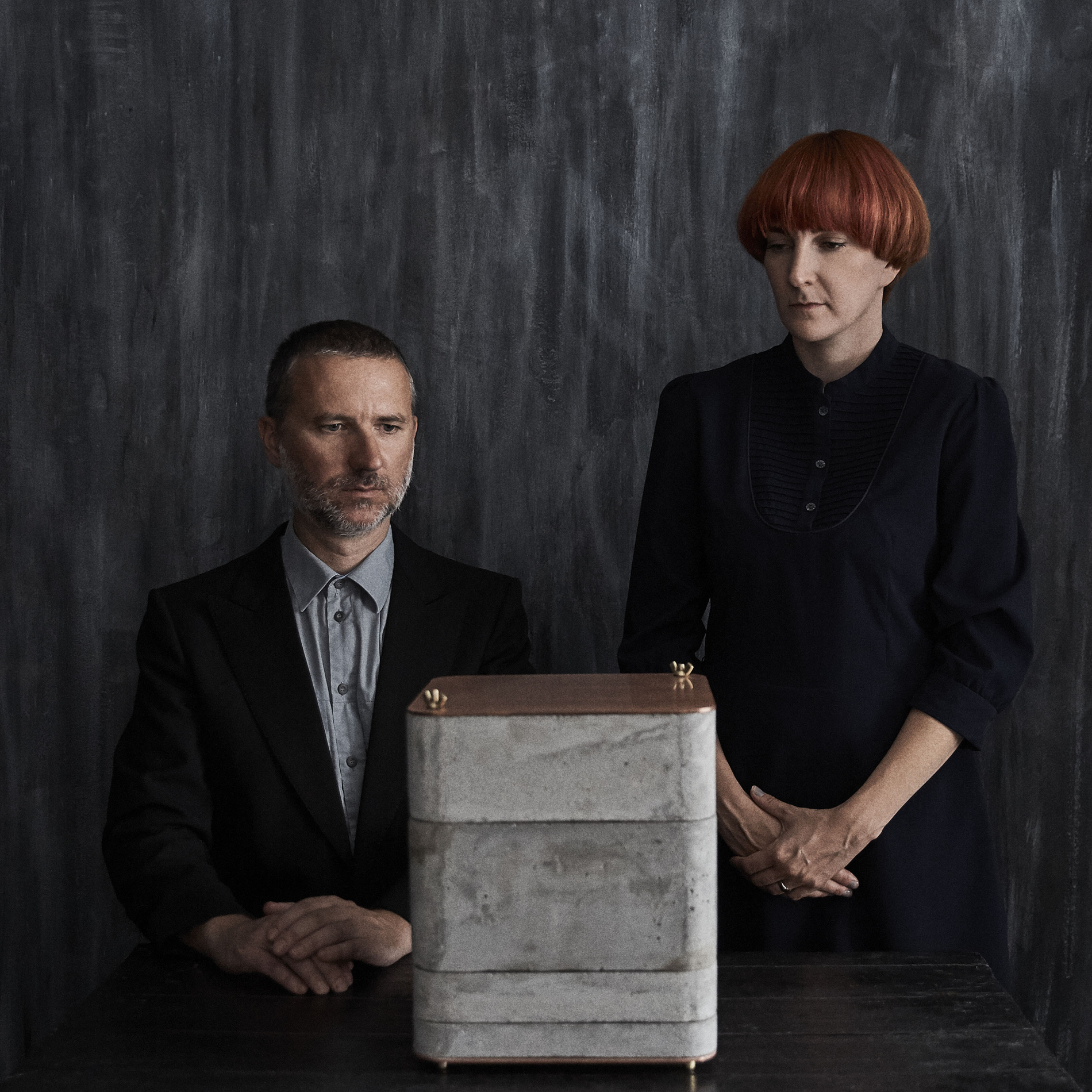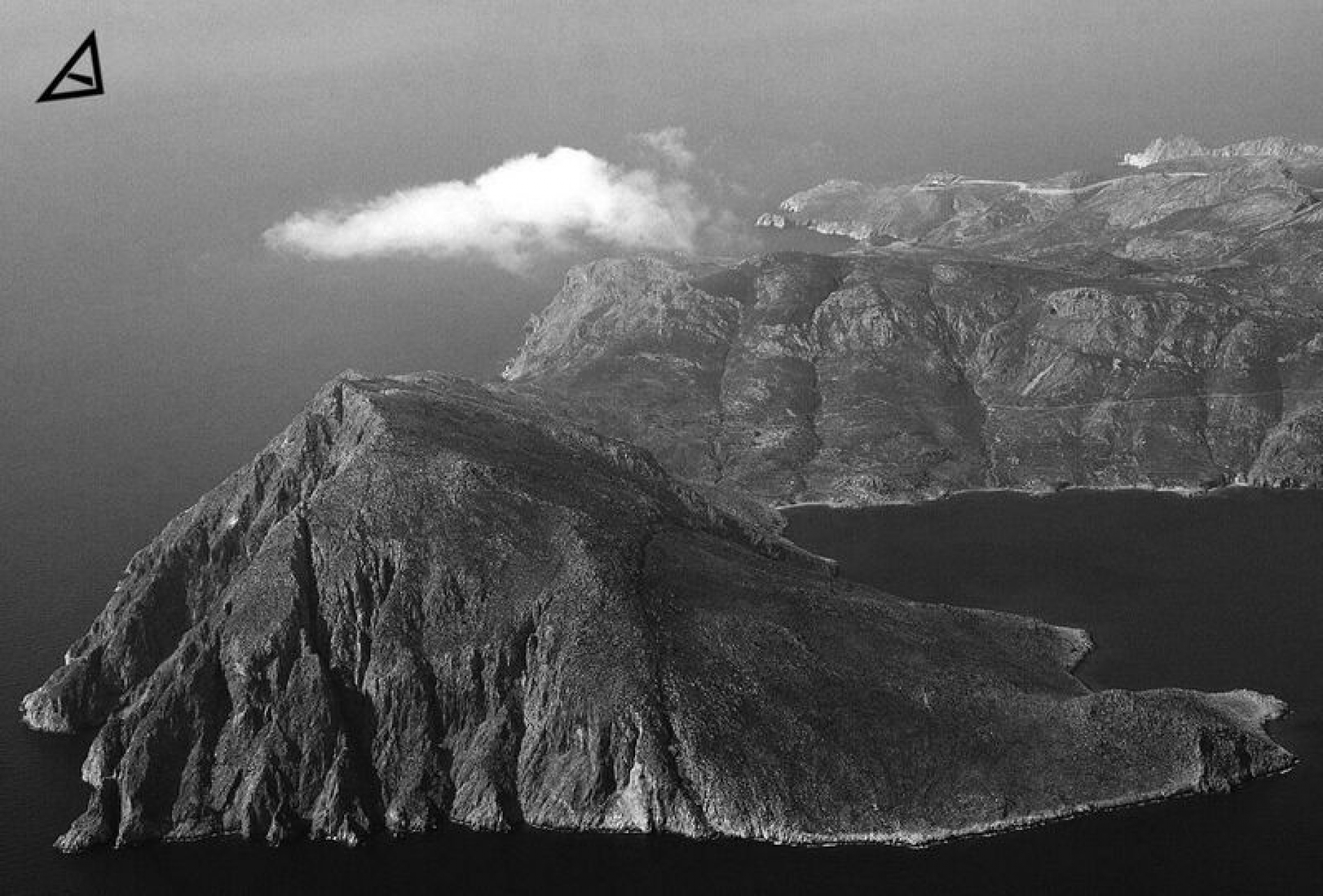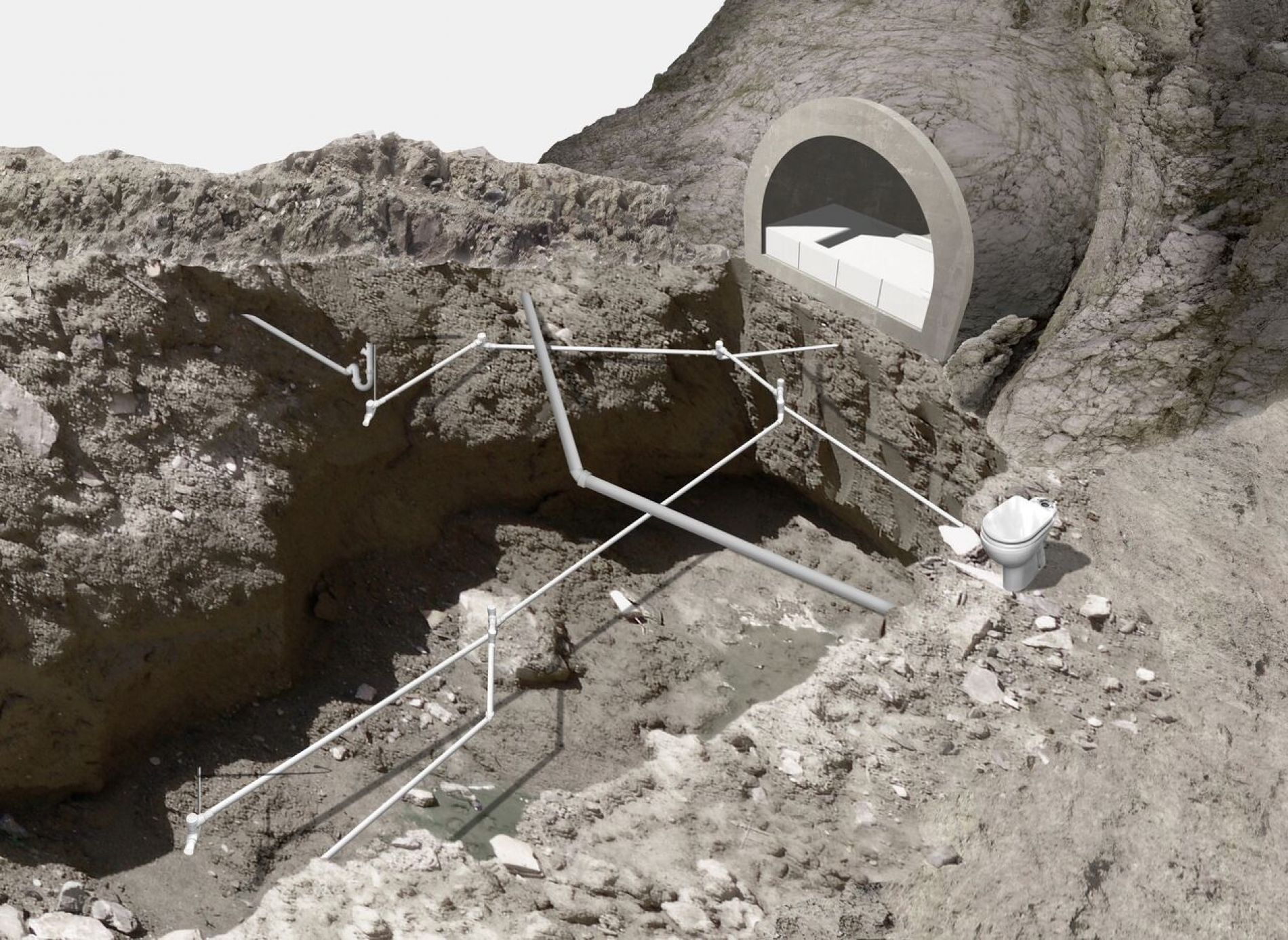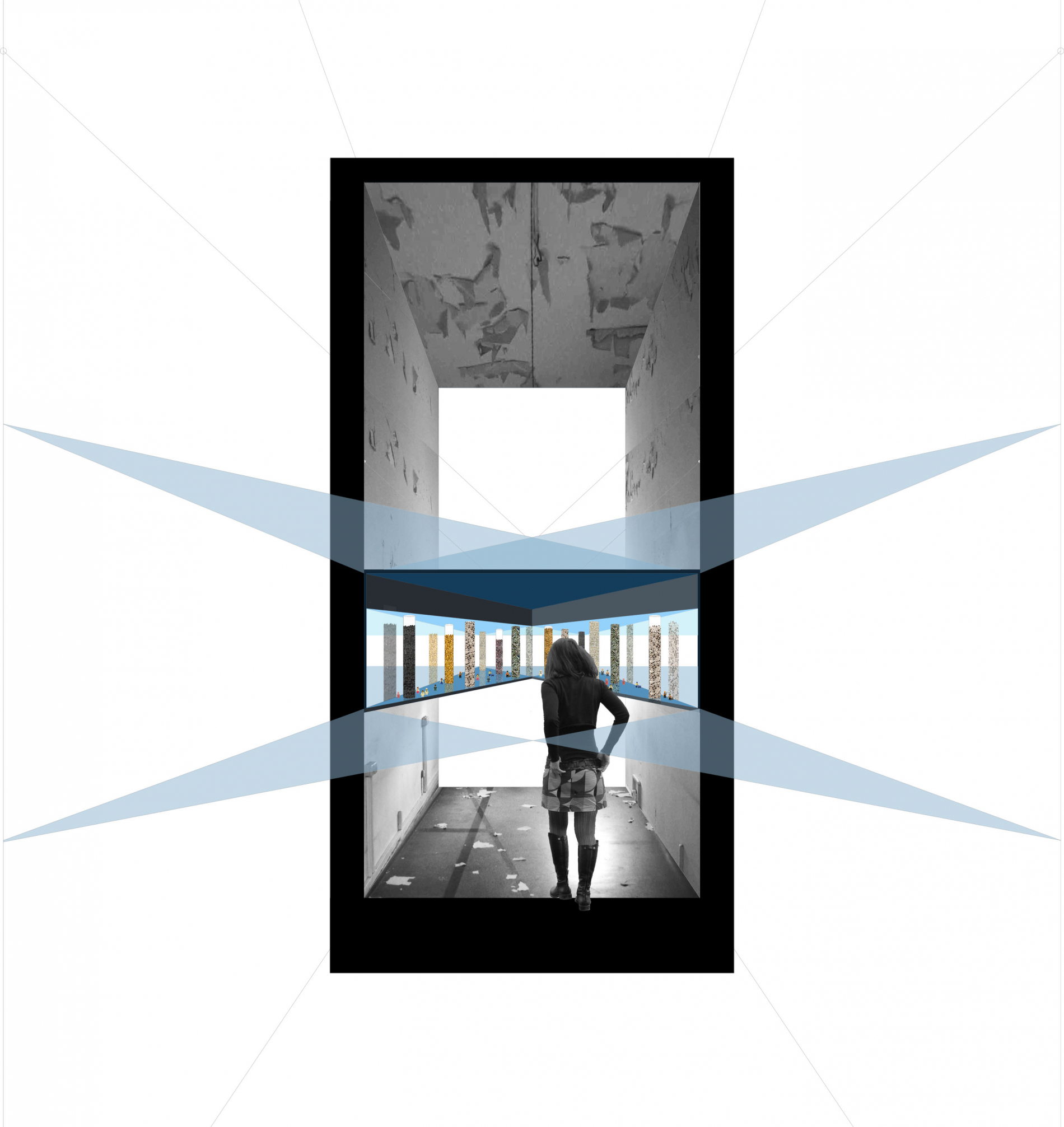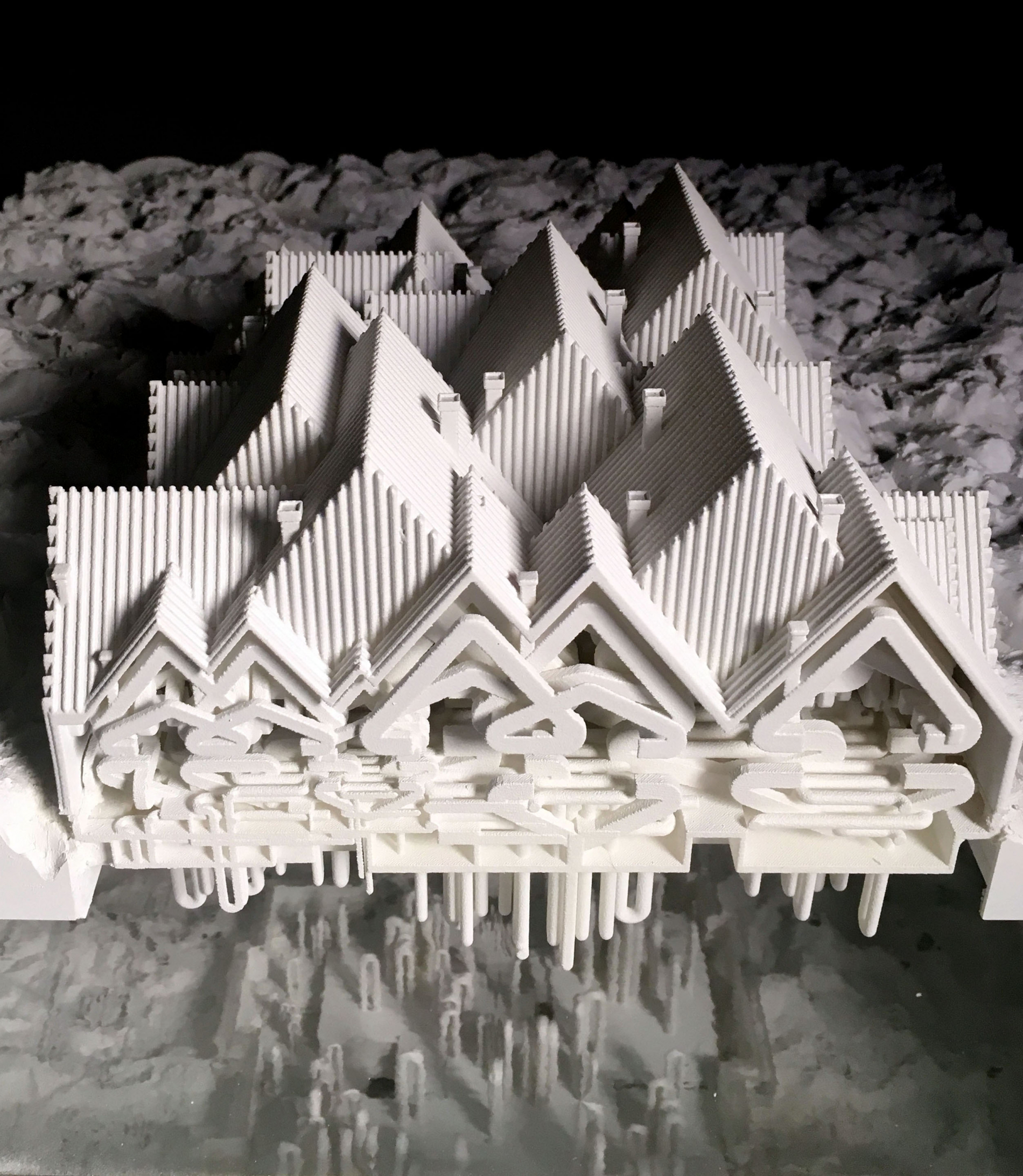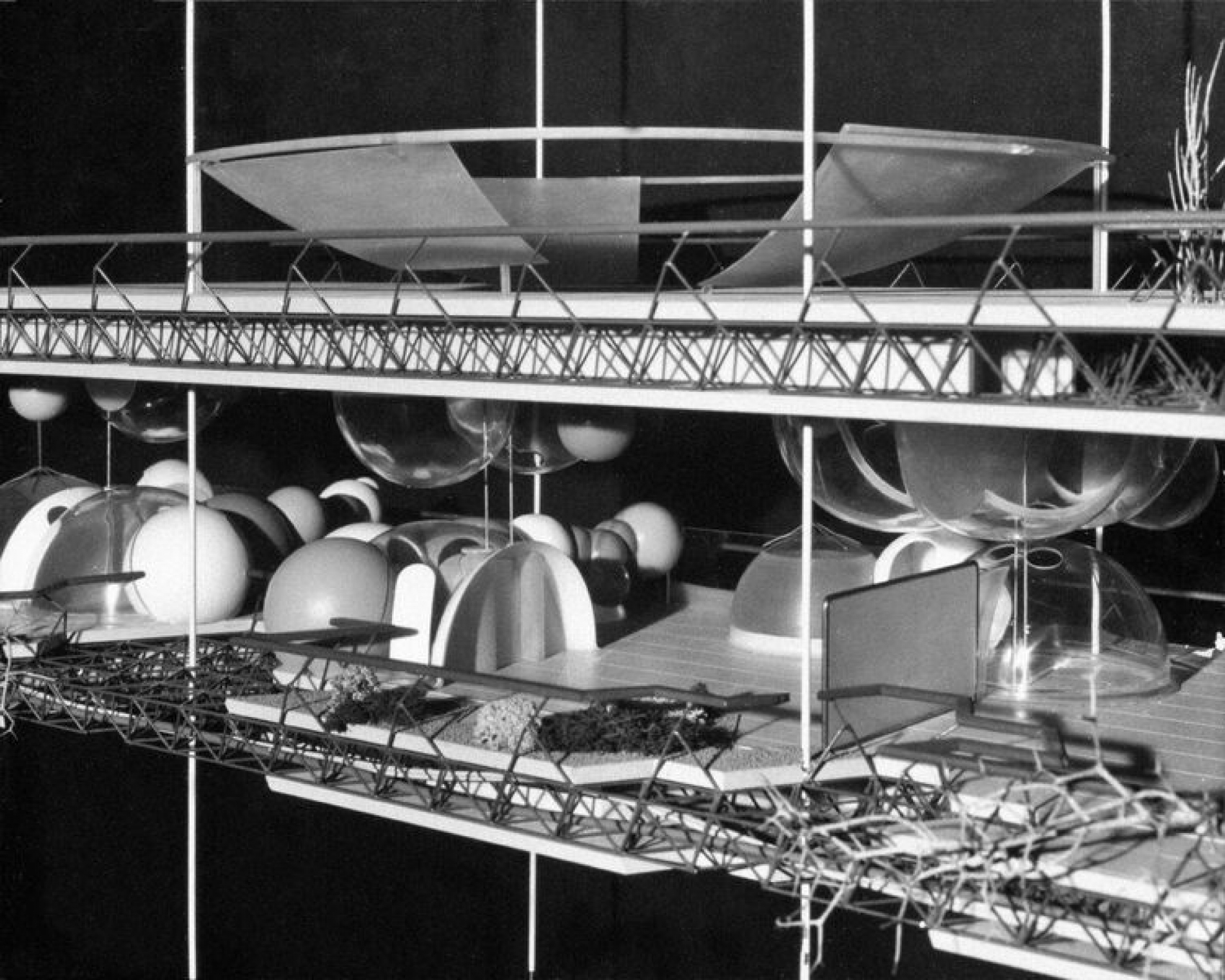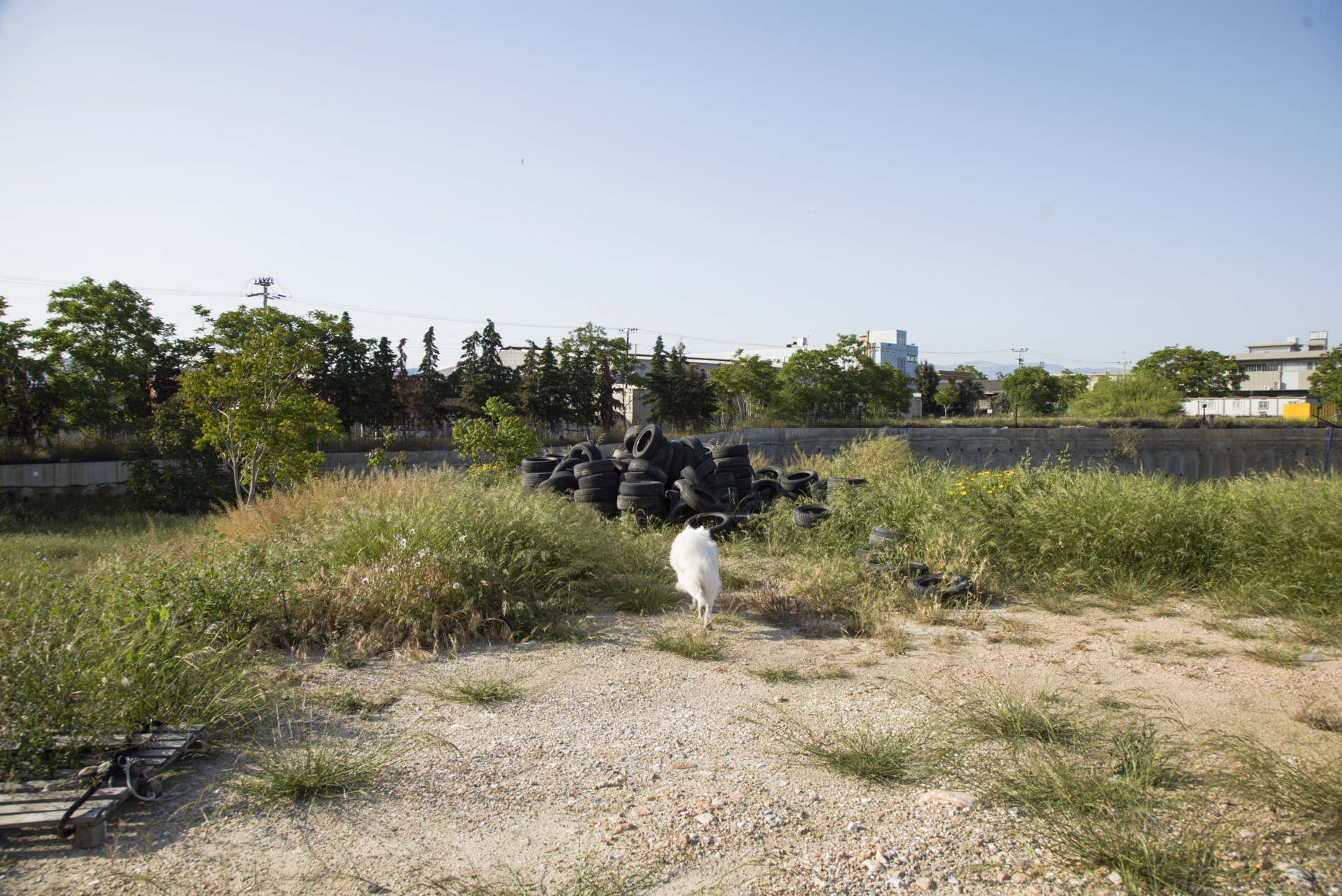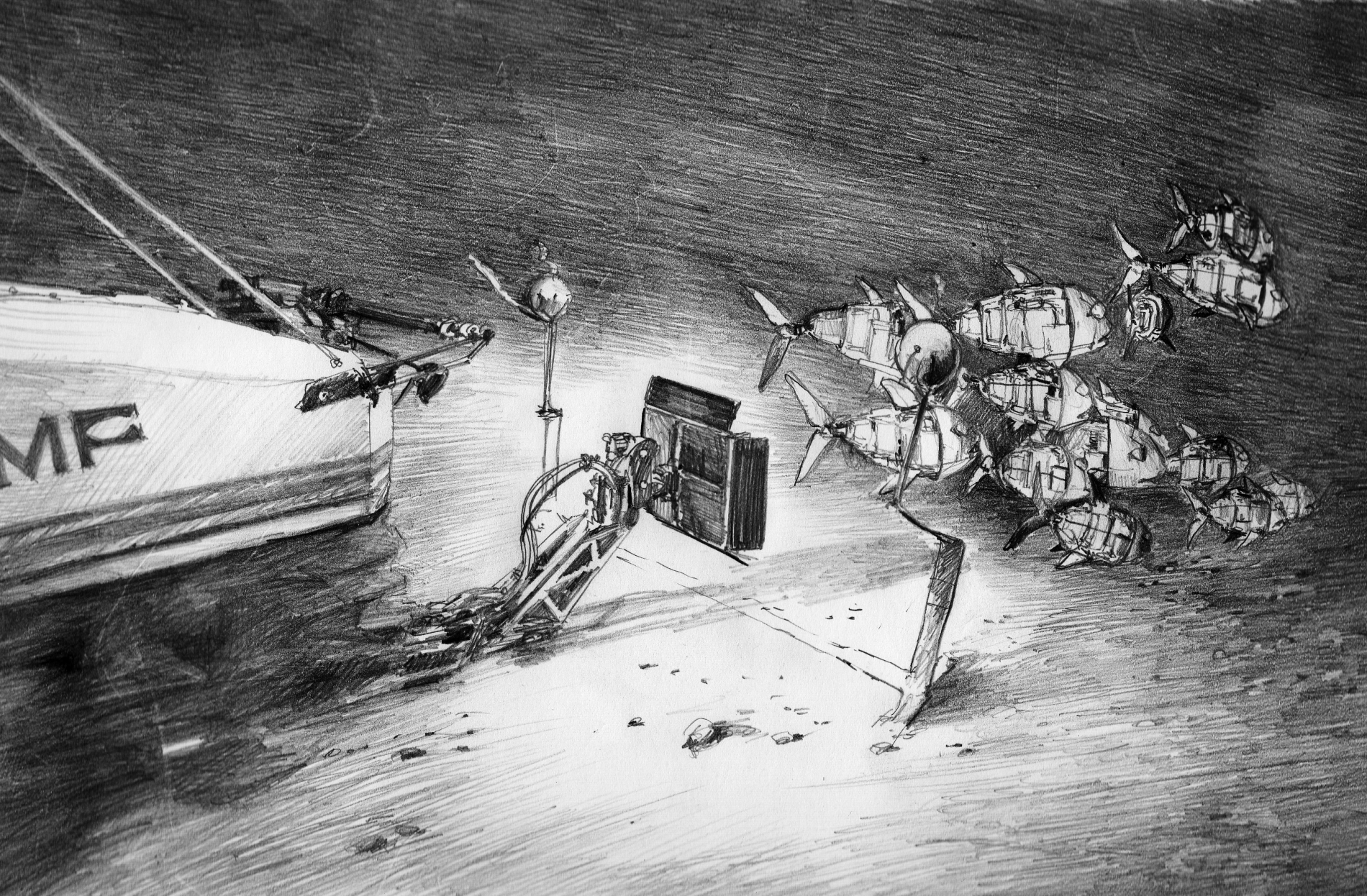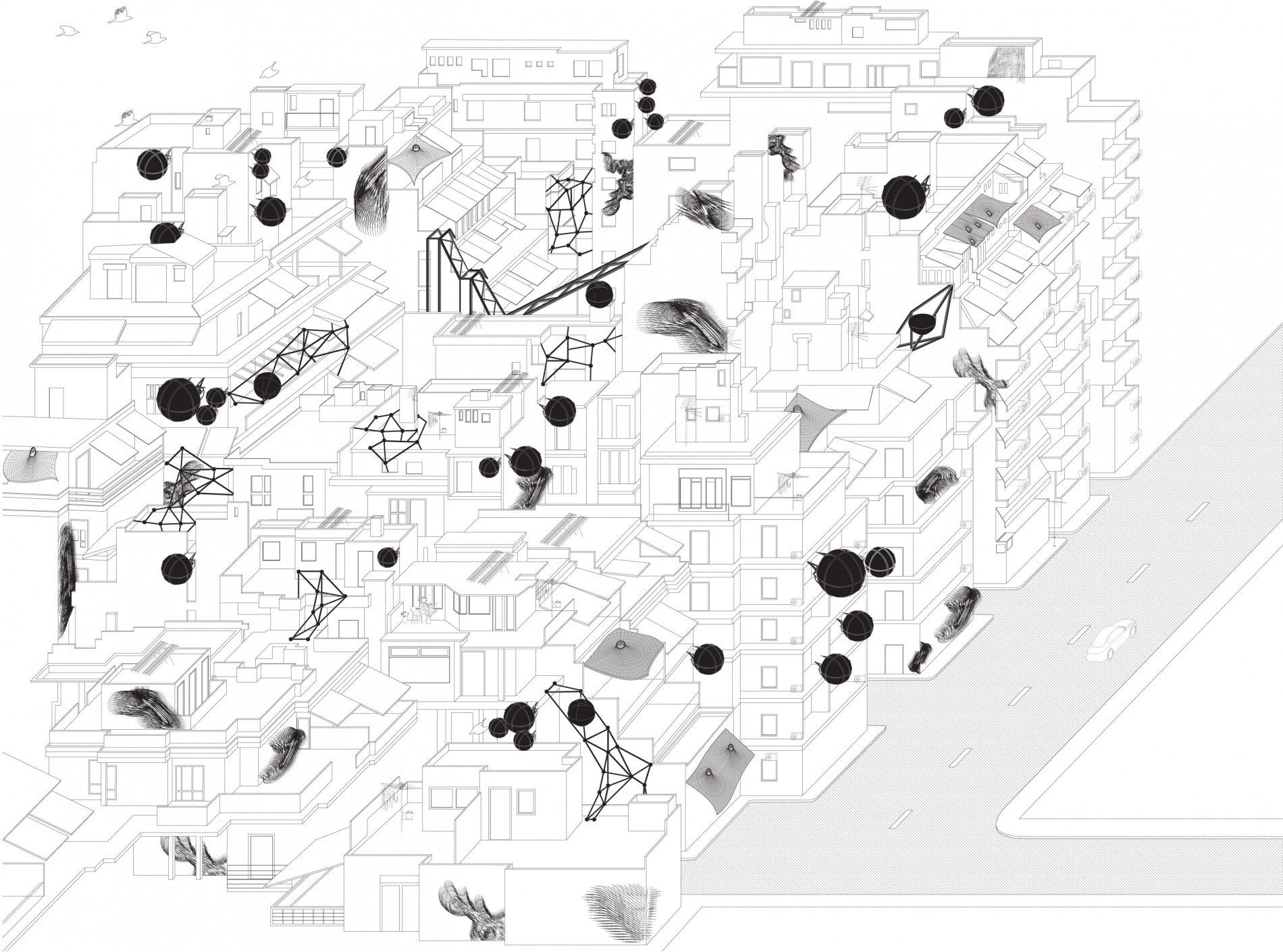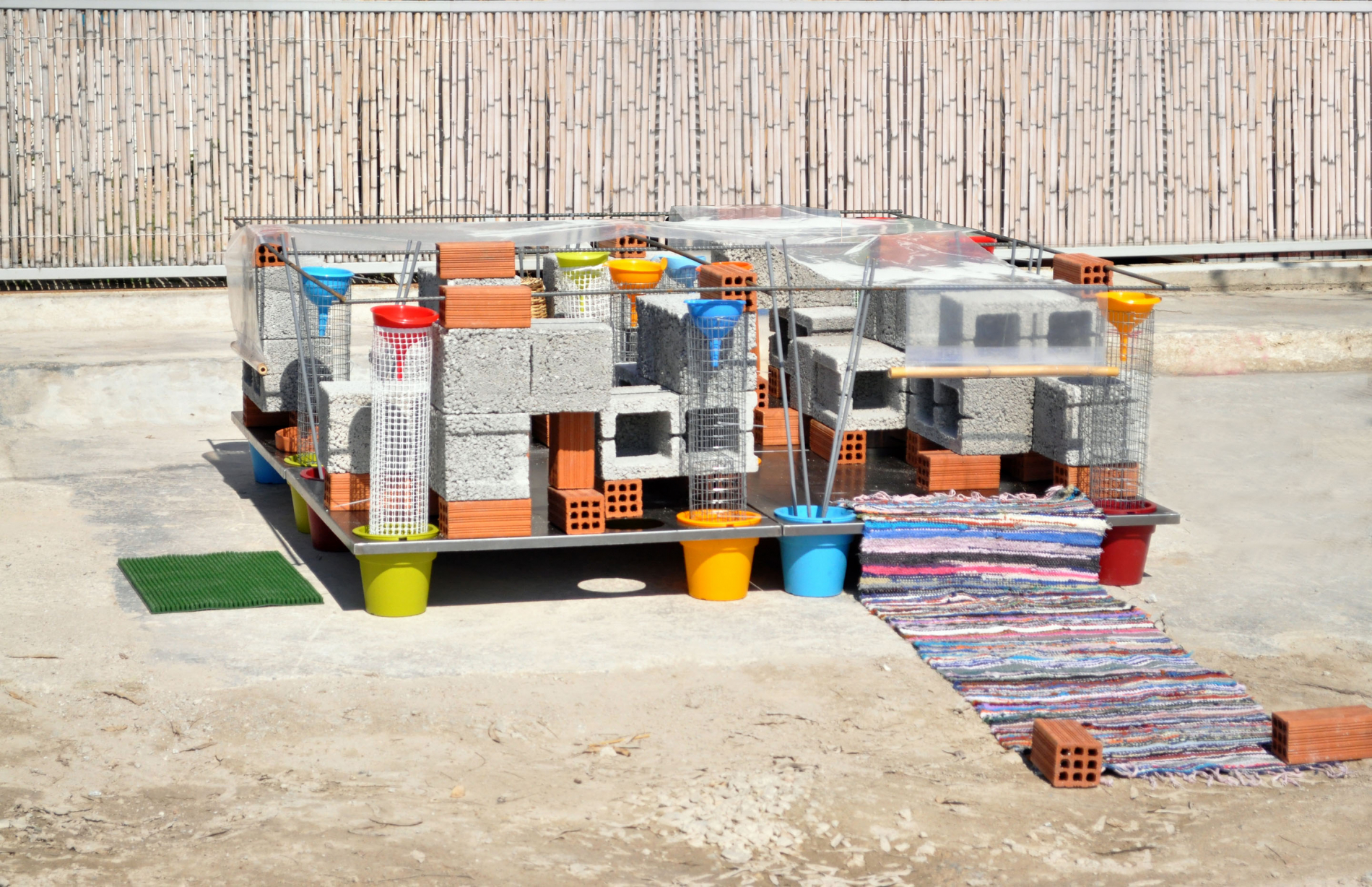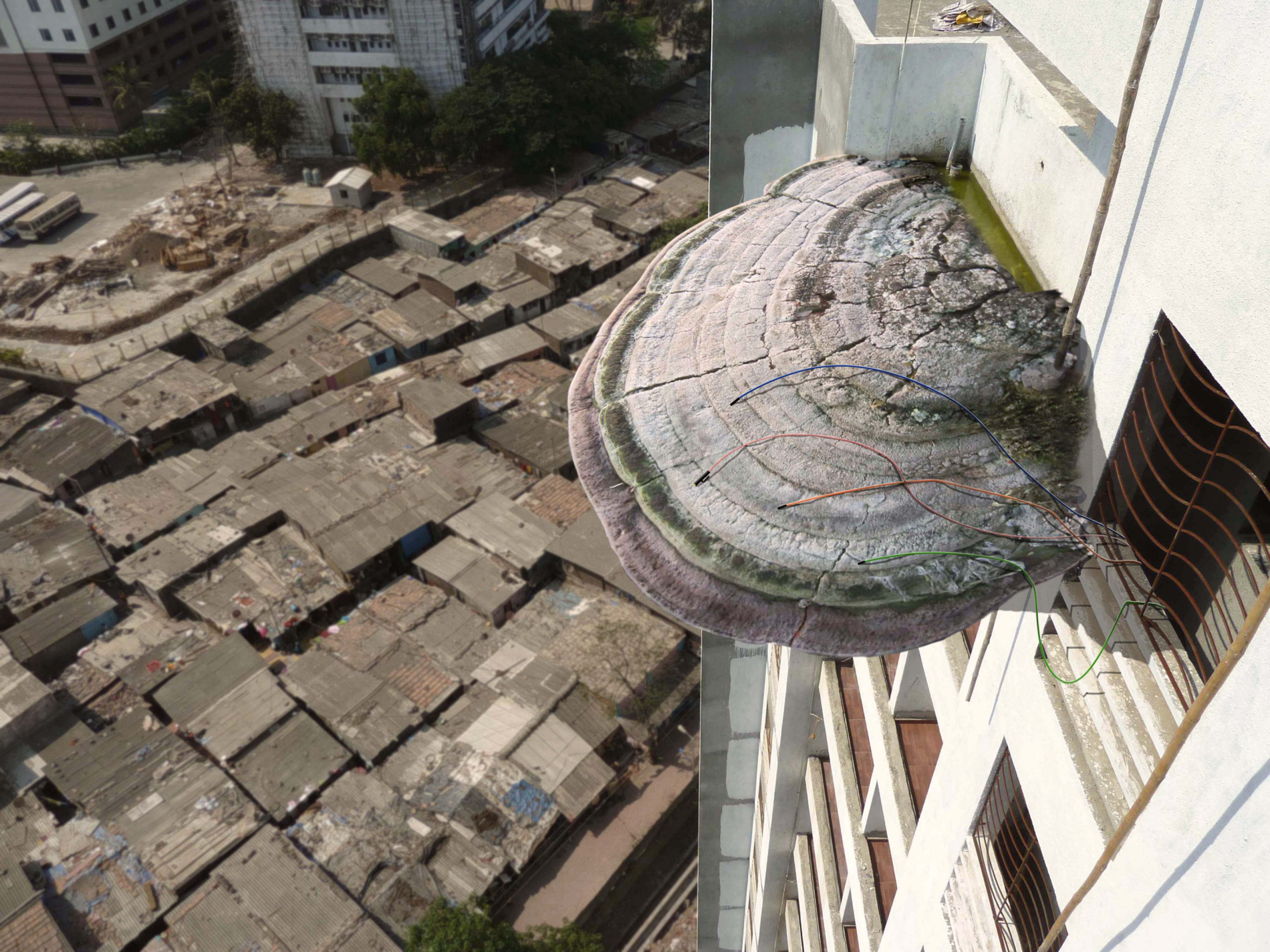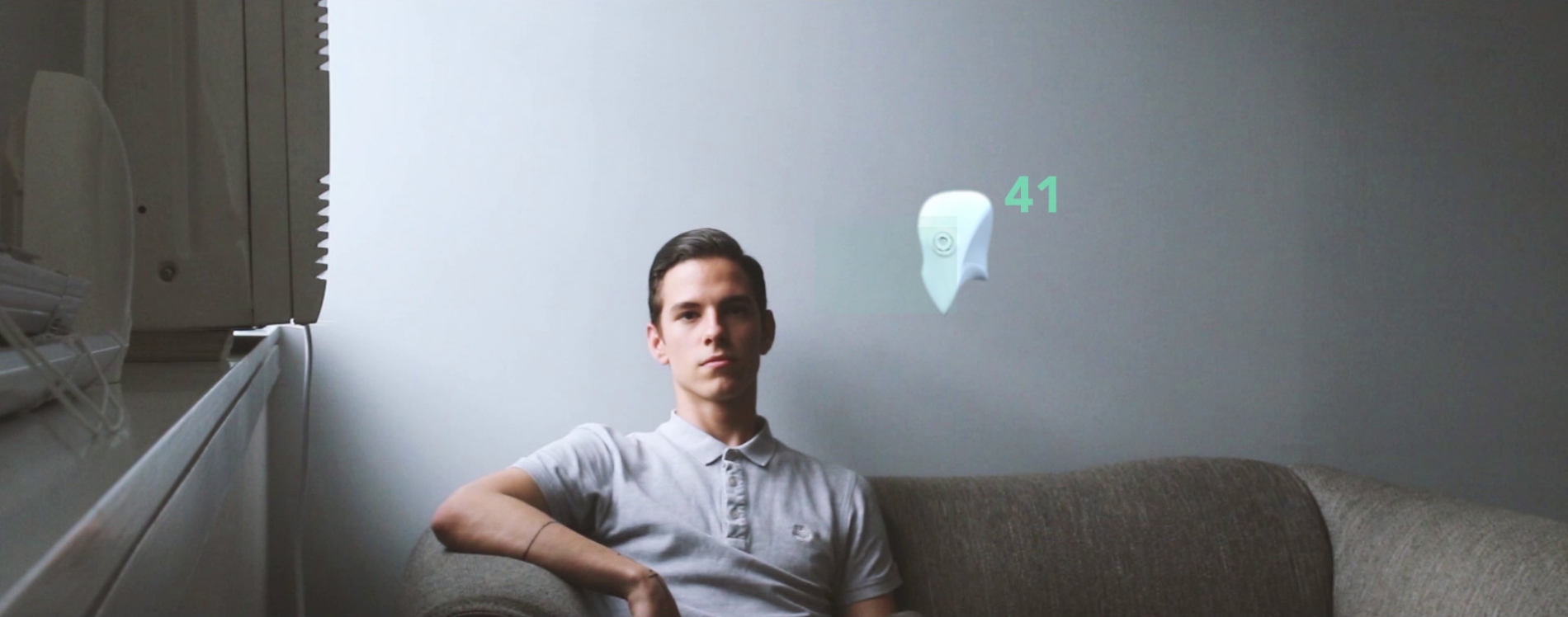
Post-natural Environments (19)
The term ‘post-nature’ makes one curious but also anxious. Why post-nature? What does the term imply? The way one perceives the natural environment undoubtedly depends on the relation they develop with it. Today’s sprawl of the cities as well as the acceleration of technological development makes the human imprint on the planet more and more visible. So, what changed to what we knew so far as natural environment, and what is foreshadowed for its future?
The exhibition hosts future landscapes capturing the ecological consequences of our contemporary way of living as well as scenarios for techno-natural environments that are developed, modified and controlled by the human. Different hypotheses are presented for the ways new systems and technologies can be used in order to balance the exploitation of natural resources, or to empower living organisms. Avoiding dystopian, or post-apocalyptic scenarios, the focus on post-natural environments aims for a new bridging between the artificial and the natural. At the same time, the projects underline the existence of the deep, geological time of the Earth, and the intertwining relationship between human and nature.
The theory of Ecumenopolis was developed by Constantinos Doxiadis' Athens Center of Ekistics as part of a research project for the “City of the Future” that was funded by the Ford Foundation.
According to Doxiadis, the great increase of urban population and the dynamic growth of cities will lead to their interconnection in a continuous network, into one universal city which we may call the ecumenic city, or Ecumenopolis. This is an inevitable reality that is already under construction and is likely to start acquiring shape at the beginning of the 22nd century. The big question that arises for Doxiadis is not about the dimensions, the structure, and the form of Ecumenopolis, but about its function, the type of life that will be created within it, and the quality of life that will offer to the people.
Doxiadis anticipates that the cities of the future will be extra-human, beyond human's capacity to control them. The world may be led to inhuman conditions as the problems and weaknesses of the 20th century's cities are multiplied. At the same time, he believes that Ecumenopolis may be “the real city of human” as for the first time in history, people will have one city rather than many cities belonging to different national, racial, religious, or local groups. Ecumenopolis will form a continuous, differentiated, but also unified texture consisting of many cells, the human communities. According to Doxiadis, this evolution corresponds to the dream of a cosmopolis, as the ideal state in which all people will be equal and united into one world.
The exhibition includes drawings, diagrams and photographs from the research project for the "City of the Future" where the theory of Ecumenopolis was developed, from lectures and publications by C.A. Doxiadis on the theory of Ekistics, and from the Delos Symposia that Doxiadis organized from 1963 to 1975. All material belongs to the Constantinos A. Doxiadis Archives.
© Constantinos and Emma Doxiadis Foundation
I don’t see highrise. I see the Mediterranean cities floating in a sea of plastics. I don’t see the cities getting smarter, I see the debris of parts, bits, bytes, pixels chasing after extensions, plug ins to get to the terminals. I see the clouds falling off the sky and there’s no sign of raindrops falling.
Mediterranean Touch Screen is an imaginary sea landscape composed of broken keys and keyboard membranes. The numerous membranes float in the idyllic blue Mediterranean while the pebbled beaches made of broken plastic keys beam seductive toxic green. The work is a networked reactivated installation; the USB ports of the membranes are rewired, interlinked and connected to a system computer where sound data of Mediterranean remembrance are archived. The transparent membranes jointly serve as a post-digital touch screen for public interfacing. Visitors are invited to touch the membranes to retrieve sound notes from the stored data. The multiple sound notes generated offer a collective (de)composition of the syncopated tunes of bygone tomorrows.
In the opening chapter of Ocean Gardens, an early handbook on aquarium care, the British artist and naturalist Noel Humphreys admonished his reader: "To appreciate Nature, the mind requires a special education, without which the eye and the ear perceive but little of the miracles passing before them." He added, "the wonders of the ocean floor do not reveal themselves to vulgar eyes."
The aquarium was born out of such desire to make sense, or represent to the senses, the inaccessible, expansive, and mysterious deep sea. Today, the call to develop “vulgar eyes” is ever timely as humans, who have declared themselves "geographic leviathans," attempt to make sense of their transformation of the ocean – of gyres of marine debris, deep-sea mining plumes, and ocean acidification. The current environmental condition seems to involve a crisis of the imagination, of the dead-end worlds of prescriptive technocratic solutions or apocalyptic scenarios, the amendment of which might depend on finding other ways of imagining nature and humanity’s relation to it.
Geographic Leviathan explores such affective agency of a cabinet of natural history in a post-natural world. The drawings appropriate the aquarium worldview to take aim at the abysmal distance between our selfish economic worries and the great scales of the Earth. Each aquarium constructs a section of the Pacific Ocean through the Clarion-Clipperton Fracture Zone. Collectively, the nine aquariums weave together the externalities of resource exploitation and climate change into spatial scales, temporalities, and species beyond the human.
The rising sea levels and coastal erosion of the Mediterranean shoreline have put the future of its cities into question. Making Shores / Making Nature proposes a rescue scenario for the Mediterranean ecosystem through the artificial lowering of the sea levels and aims for a new topography thanks to a combination of anthropogenic, technological and natural drivers of change. By entangling the coastal territory and its materiality into an exaggerated sci-fi framework, the project speculates about the environmental consequences of a future when nature and landscape will be manmade. Which new spatial relations will surface in the previously submerged terrains of the Mediterranean? What material data can be revealed in these futuristic shores? Can these composite substances give birth to a new material technology in an era of resource depletion?
Making Shores / Making Nature explores these questions, through engaging with the processes of material scavenging and of 3D prototyping nature. The work is a 3-part visual essay consisting of a publication on the process, material fragments of the new shores and 3D prints of the new seascape units, based on the form of a Mediterranean seashell.
The elusive presence of global warming – rendered visible only at the very local effects of climate change such as in the case of coastal flooding – serves as a harbinger of tomorrow’s world; it foreshadows a displacement of Western civilization’s anthropocentric orientation in both experiential and philosophical terms. If our previous concept of ‘world’ was premised on the assumption that humans exist outside of ‘nature,’ today’s understanding of tomorrow’s ‘world’ renders such distinctions between human and nonhuman space transitional and thus inherently ambiguous.
Τransitional Environments brings together the work of Cathryn Dwyre and Chris Perry, their interdisciplinary design practice pneumastudio, as well as their academic design research conducted at Pratt Institute and Rensselaer Polytechnic Institute, respectively. Viewed as larger body of design research, the work explores the simultaneous proximity of and separation between human and nonhuman space by producing transitional material, formal, spatial, and programmatic conditions. Irreducible to one state or the other, these transitional environments are inherently ‘postnatural’; rather than seek a resolution to the nature-culture conflict that characterizes our contemporary moment, they instead seek to reveal new forms of critical awareness and creative potential by embracing it.
The installation hosts the following projects:
A Curious Cabinet by pneumastudio (Cathryn Dwyre and Chris Perry), 2017
Anthropocene Folly by pneumastudio (Cathryn Dwyre and Chris Perry), 2015
Into the Fog by Gabriela Fiorentino and Yara Kawar (thesis students), Cathryn Dwyre and Richard Sarrach (studio critics), Pratt School of Architecture, 2016
Scar City by Dariusz Kulinski and Skye Ruozzi (thesis students), Cathryn Dwyre and Richard Sarrach (studio critics), Pratt School of Architecture, 2016
Disfigured Landscapes by Jacob Wigton (thesis student), Chris Perry (studio critic), Rensselaer School of Architecture, 2016
Transgenic Environments by Hailey Beyer (thesis student), Chris Perry (studio critic), Rensselaer School of Architecture, 2016
The era of human scale art and design may be over. Increasingly, we need forms of intervention that take into account the deep, temporal impact of material processes and practices. Whilst developing planetary modes of vision, communication, and control we have altered the very ecosystems we seek to assert mastery over. In rendering the entire Earth an object of scientific study and commercial interest we have become implicated in the deep futures of every organism that grows, crawls, and blooms on its surface. Alongside this our economic and social systems have become so entwined with the natural order we separate ourselves from, that they have begun to evolve like organisms themselves, mutating beyond our capacity to understand them. As Richard Pell and Lauren Allen outline in their definition of post-nature, human beings inhabit a world where organisms, their habitats and evolutionary niches, are no longer determined simply by ecological pressures, but by an ongoing negotiation between commerce, regulation, and genetics 1, a relationship that, we argue, increasingly works both ways.
Beginning from their contributions to The 3D Additivist Cookbook, artists Geraldine Juarez, Antonio Esparza, Darlene Farris-Labar, and the collective ARTKELAB, offer works for this exhibition that probe the concept of the post-natural. The works intervene on synthetic/natural, technological/cultural boundaries using 3D fabrication as a tool for critical, poetic, and playful activism. Each work tackles questions of significant contemporary relevance to the Mediterranean region from ludicrous dystopian futures, offering post-natural hybrids as conduits for weird forms of political engagement that might have a chance of altering our understanding of the cultural now.
1 "Out of the Lab, Into the Wild - Center for PostNatural History." Accessed January 11, 2016.
http://postnatural.org/Out-of-the-Lab-Into-the-Wild
The installation features:
The 3D Additivist Manifesto by Morehshin Allahyari and Daniel Rourke, with sound design by Andrea Young, 2015
The 3D Additivist Cookbook by Morehshin Allahyari and Daniel Rourke, 2016-17
USOA 1.0 (Ultimate Software Open Animal) by ARTKELAB, 2015-17
Kauri by Geraldine Juárez, 2015-17
Ancient Mediterranean Flowers from the Soil's Edge by Darlene Farris-LaBar, 2017
The TurtleBag by Antonio Esparza, 2016-17
The 3D printed objects were produced especially for this exhibition.
"Nobody remembers why it was radioactive in the first place."
As the world turns again towards nuclear power, producing readily available energy but also waste toxic for millions of years, urgent questions once again emerge: What do we leave behind, what will the future inherit from us? How can we as individuals and society deal with the scales and scopes of deep time? How can we make sense of the vast time-scales involved?
Inheritance consists of precious jewelry, a necklace, earing and a broché, which are radioactive and therefore, rendered practically and symbolically unwearable for deep time, until the radionuclide transmutes naturally into a stable and non-radioactive isotope of lead. Together with an electromechanical device to determine the remaining radioactivity the jewelry is stored in a concrete container which is built to endure over a vast amount of time. With these items the story goes that each time the jewelry is handed over from one generation to the next, the ritual of measurement determines if the jewelry can finally be brought in use and fulfill its promise of wealth and identity or if it has to be stored away until the next generation.
The Mediterranean Sea, in the sidelined European South, has been the stage of major tensions and urgencies due to its geographical particularity and cultural diversity: climate change, population movements, financial crisis, military and political conflicts, tourist exploitation. Part of the Mediterranean Sea, the Aegean archipelago connects but also divides two continents being therefore of crucial importance for many centuries in this area. Having opposed numerous gentrification attempts and investment plans during the last decades, the archipelago is found to accommodate in the future a decentralized network of small, fully sustainable, climate-controlled data centers, constructed on the islands or floating on the water, which enables people to safely and privately store and share their digital information and memory without relying on any kind of corporate cloud. This network of data centers managed by the islanders brings into form a kind of local traditional platform cooperativism. The islanders’ community consists of people who abandoned the urban centers of Europe, former refugees and indigenous islanders. In the face of the harsh and erratic regional conditions, the Aegean Datahaven connects the islands with each other creating new topologies and questioning at the same time the established forms of sovereignty, identity, geography and power. An extended archive of the data centers can be found in the Aegean Datahaven collection. The data centers are depicted on a series of drawings by an unknown traveler.
The Cave for an Unknown Traveler is an installation composed as a scenario for a ‘fake archaic cave,’ which is nevertheless equipped with the infrastructural luxury of a modern hotel room. It is organized with a tartan floor in the color of the ground, an open-air sink, toilet and shower, a diligently hidden infrastructure, an elementary space for storage, and a simple bed lying under a concrete vault. The setting brings some of the accessories of a hotel room to the natural environment of a deserted island. A system of such distant caves creates a complex equivalent to a ‘natural hotel.' The natural hotel is completed with a system of invisible services. There are plenty of them, yet all meticulously veiled. The Cave for an Unknown Traveler gives the possibility of a supposedly isolated stay in a deserted island, while this is only supported as a scenographic condition.
16.05.2117, 20:20
...spearmint, fennel, thyme, oregano – check
...grapes, peaches, cherries, melons – check
...olives, sesame, figs – check
...wheat, barley, almonds, walnuts – check
collecting, sorting, drying, depositing, freezing, sealing, exchanging – transactions completed
16.05.2017, 20:20
The spectator stoops slowly, inserts themselves in the inspection hole, observes the silos-displays, surveils the activities of community workers, experiences the architecture, is being lost in space.
Silo(e)scapes envisions a hybrid of a seed bank, a sharing economy and a museum for Mediterranean plant species that may disappear. In Silo(e)scapes techno-utopia, the threatened native seeds are stored in transparent silos/museum displays which are also the columns of a communal architecture. Silo(e)scapes provides to community workers the preservation of local seeds biodiversity and the protection of Mediterranean tastes, flavors, nutrients, and medicinal capacities threatened by environmental catastrophes as well as the increasing demand for control and standardization. Silo(e)scapes does not belong to private corporations. The members of Silo(e)scapes share the contents of the deposits. Autarky is a priority. And so is freedom and security.
Is the future of Mediterranean food a ruined landscape? Silo(e)scapes art installation transforms the anxiety of such dystopia into the experience of a futuristic architecture. In Silo(e)scapes spectators surveil a doll-house metaphor of a futuristic microcosmos through a panopticon structure that expands in infinity. Silo(e)scapes functions as a wearable room, a portal between reality and fantasy: Spectators insert their head into a hole to observe the threatened species, the seed bank museum, and the sharing economy of Lilliputian citizens. The seed-columns of the infinite space, the kaleidoscope of mirrors and agrarian sounds construct a perceptible space, which is neither real, nor a replica; it is rather artificial and illusive. Silo(e)scapes is both threatening and seductive. The theatrical and voyeuristic experience of Silo(e)scapes forms an apparatus that awakens memories, but also empowers spectators to disrupt the sequence of events causing the disappearance of these species.
In the fall of 2016, nine students at the Yale University School of Architecture documented the future infrastructure of Iceland over a 20-year period from 2036 to 2056. This was a speculative archival project 20 years in the past of 40 years from now. The infrastructure was rethought in light of contemporary developments in ecology, technology, and economics; these three issues effect the cultural relations of the built environment at such an accelerating pace that is difficult for a discipline such as architecture to grapple with. The question that the studio dealt with is not the fantasy that architecture can solve these problems, but that architecture is responsible for imagining the aesthetics that the interrelations of these three would provoke in the near future. The participants explored how these accelerated changes redistribute sensible information, and therefore involve politics. The projects presented range in scale and issues addressed. Three general categories were developed, although each project crossed over into the others: Energy Extractio, Distribution Systems, and Information Storage. Each project is documented through 9 images, 1 model, a brief text, and a presentation of research documenting the future media.
List of works:
In Plain Sight by Heather Bizon
Iceland Resolution: The View from Nowhere by Mathew Bohne
Tesla Redoux - Iceland Probe System Report by Pauline Caubel
The Glacial Genome: Looking Back at the Mid-Atlantic Mediation Project by Cat Garcia-Menocal
InfoState Infrastructure by Paul J. Lorenz
From BIM to Garage Bands: The Rise of Energy Hacking by Aymar Marino-Maza
The Hive: The Distribution of the Many by Steven McNamara
Data Landscaping: The Highland Dermis by Maggie Tsang
Razor Mining: Refueling the Cloud by Rob Yoo
Electronic Urbanism is a research project in progress for more than 20 years. The first research stage starts during Zenetos' studies in Paris and concludes with the first presentation of the project at the Modern Housing Organization's exhibition in Athens in 1962. The final project for the "City and the house of the future" is presented at the 1st Building Exhibition at Zappeion in 1971. In this project, Zenetos has adapted his design for an all-purpose furniture that was distinguished in the Interdesign 2000 competition (1967).
Zenetos' project for the city of the future is the outcome of systematic research on the development of applications in electronics. Studying articles in scientific journals of the time, Zenetos defines accurately the forthcoming applications of 'tele-management', 'tele-work' and 'tele-services'. Taking into consideration the accelerating changes of living elements in the cities of the future, he proposed flexible systems for both building and infrastructures. He believed that the structure of the city and the house of tomorrow would have to be ephemeral and, as much as possible, immaterial. For this reason, he designed a system of light three-dimensional supporting cable-structures, like a spider's web, containing vertical garden-cities and dense networks of improved telecommunications media. The ground, which was left almost free, was an uninterrupted natural space as the city would expand over forests, lakes, rivers, and seas.
This space structure can receive any type of infill elements, but the most important one is that of the moveable tele-processing cell. The cell is equipped with ananthropomorphic all-purpose furniture, which controls the tele-activities, the audiovisual contacts, and the environmental conditions. According to Zenetos, this control switch is going to be the heart of the human of tomorrow. The adjustment of the furniture's various parts is mechanical through keys, but Zenetos already forecasts that in the future this will be controlled directly by the user's brain, with the help of a hyper-sensitive electro-brain waves receiver.
The material that is presented in the exhibition belongs to the Takis Ch. Zenetos archive.
Feral Remnants (Dog) offers a poetic projection onto a further future with no human presence in sight. The work is a multimedia installation consisting of a metal tank filled with black oil and an HD video with an original music score. The video features a purebred Samoyed dog being shot wandering in an empty environment in slow motion. The musical score (Medieval, 2016, composed by Ori, the artist’s rock trio) creates a certain dystopic heavy atmosphere, yet the screaming voice evokes a sense of riot. No human is to be seen. The dog is reversely projected onto the wall screen, and distortedly reflected on the petroleum which trembles according to the bass sequences of the music. Petroleum evokes the silent hope of discovering oil under the Greek territory, while also stands as a symbol of a pragmatic vision of tomorrow and a blurry dysfunctional dream. The modernist design of the iron tank refers to an idealistic envisaging of the future, while the sculpture mediates the viewing of the abstract and poetic image of the dog. However, the work inevitably describes a future where the lonely dog runs loose in an environment where humans are extinct. Depending on the interpretation of the installation, the viewer is left with an ambivalent sense of melancholia or a certain spark of promise about the future.
Courtesy of CAN Christina Androulidaki gallery
α2525, Athens in S.F. is based on 13 short stories written by 10 Greek sci-fi authors, who were specifically commissioned to provide them imagining the future of Athens. It is a film project that was subsequently created to address the questions, images and ideas presented in the utopian or dystopian scenarios of the authors. In the form of an omnibus documentary, which makes use of interviews, videos and drawings, the film evokes the writers' visions and hypotheses regarding the city's future in different time periods. The project touches upon several issues such as: climate change; possible epidemics; the application of augmented reality in public space; the fusion of cities through virtual reality; the uncontrollable dissemination of fake news; religious fanaticism; a future society based on collectivity; a new autocratic plan of global development; technologies that are beyond man's control or trigger global geopolitical shifts. The film is accompanied by the published stories on which it is based.
Air Shake examines the character of air pollutants in Athens of the year 2027 to imagine both an array of future diseases and cures. It documents phenomena of leaching caused by a variety of chemicals that have been released into the atmosphere and their scientific, economic, and social attributes. Air Shake projects current urban habits in plausible future scenarios extracted from the present, based on the impact that different mixtures of air impose on human bodily systems. The project imagines an array of diseases that have begun to manifest in 2012, with Athens registering the highest levels of atmospheric pollution in decades. Because of the debt crisis and the citizens’ denial to yield to the overblown energy taxation, the continuous combustion of random cheap available materials, has resulted in the excessive release of particulate matter, sulfur dioxide, carbon monoxide, and other carcinogens, eventually disemboweling the livelihood of citizens and their right breathe in the city. The projection of four speculative diseases onto the urban environment takes form as a series of healing environments, making visible the linkage between the air pollution and the imagined disease. The Air Shake installation operates around two systems that together create an immersive experience. First, there is a series of chimneys, which present the city upside-down, spewing different shakes of air mixes to heal city dwellers. A secondary system is visualizing the air shakes each chimney spews in a virtual reality environment, accessible through a series of movable tablets installed in the room. The installation space is imagined as a virtual healing environment that allows the physical embodiment of the visitors to project and immerse themselves in a series of future atmospheres.
A Hothouse is a techno-natural apparatus providing a controlled, warm environment for cultivating plants. On the other hand, a Concentration Camp is a gated settlement for people excepted from law protection, usually under the condition of obligatory labour. Connecting the two terms and programs in a hybrid one, Hot_Camp is introduced as an apparatus for collective living and working in the margins or in-between cities. It intends to provide a spatial and performative condition under which metropolitan life melts into rural life and vice versa. Life for moving people in a state of emergency is challenged to form an open community. The assemblage of people with controversial identities reflects in an architectural assemblage of various living spaces, objects and organic apparatuses. All these form an alternative urban block, generic, awaiting to be grounded anywhere, as a colony between the city and the land. This trans-urban block refers to the precarious conditions of tomorrows’ life, in relevance to the South, under the Mediterranean climatic, anthropological and political horizon.
During the Indian Civil War, the Dharavi slums of Mumbai were flooded with refugees looking to escape the conflict. The Mumbai authorities, distracted by defense of the city and facing an already over-populated and poverty stricken slum could do little to maintain a semblance of civilised life in the area. Sometime later a cache of biological samples appeared through the criminal networks of Mumbai, in the vain hope that it might provide new marketable narcotic opportunities. The collective drive and expertise of the refugees managed to turn these genetically-engineered fungal samples into a new type of infrastructure providing heat, light and building material for the refugees. Dharavi rapidly evolved its own micro-economy based around the mushrooms. This documentary tells the story of some of the characters involved from Mumbai and the rest of the world and how Dharavi came to be such a unique place.
The 1950’s television series The Twilight Zone was a series focusing on the cross over between humanity’s fear, intelligence and superstition. In the original series, an episode called “The Lonely” focused on a man sent to prison on asteroid for solitary confinement but falls in love with a woman like robot who becomes his companion. In that time, our fears were catalysed through magic or science fiction, but our fears now lie in the unprecedented growth of technology. With our smartphones becoming a deposit of our life, our friend, what will this relationship be in 50 years? Speculative design can help us extrapolate our current beliefs onto to tomorrow’s technology. During a schooling semester, students were asked to design objects over the next three generations. The overwhelming majority focused on companionship, a friend from birth till death. With our fears and superstitions turned up to a deafening volume we can speculatively assess what future designers of technology companionship should consider. The works present students’ different fears and excitements over the future of technological friendship, consulting complex realm of ethics, reality and logic. Some are optimistic, some are not but upon meta-analysis of all the students' views it becomes apparent that the future of technological companionship is under negotiation.
3D printed objects sponsored by Stratasys Ltd. using J750 full-colour multi-material printing technology.
Featuring the following projects:
Play, Protect, Preserve, by Nicole Hone
Bot, by Evangeline Martin
Postcards from Mars, by Loek Hendriks


